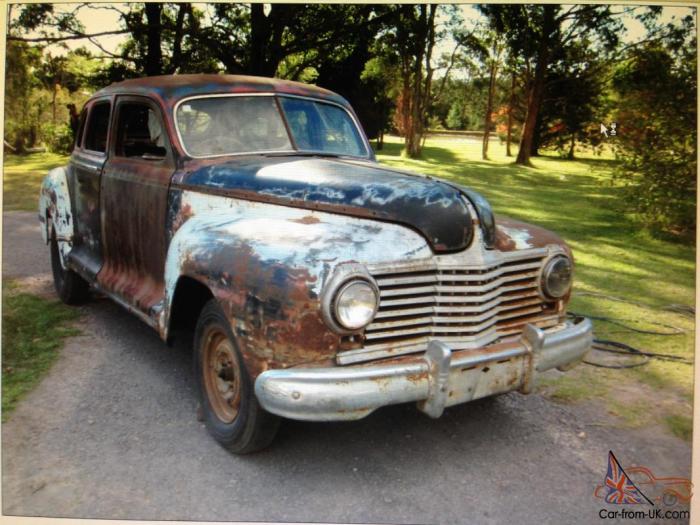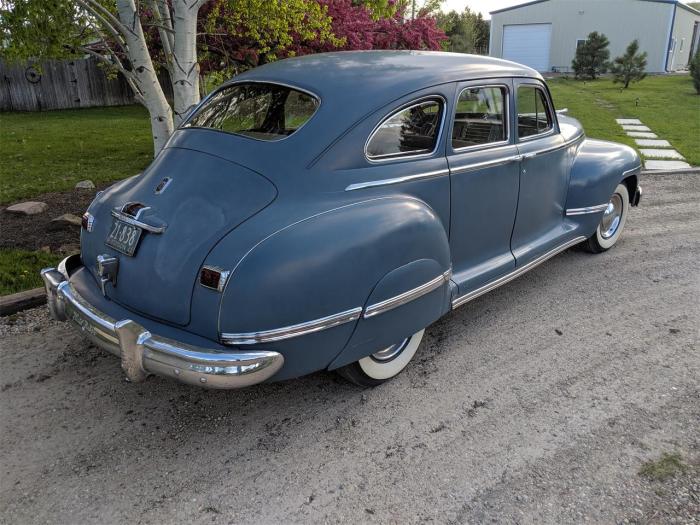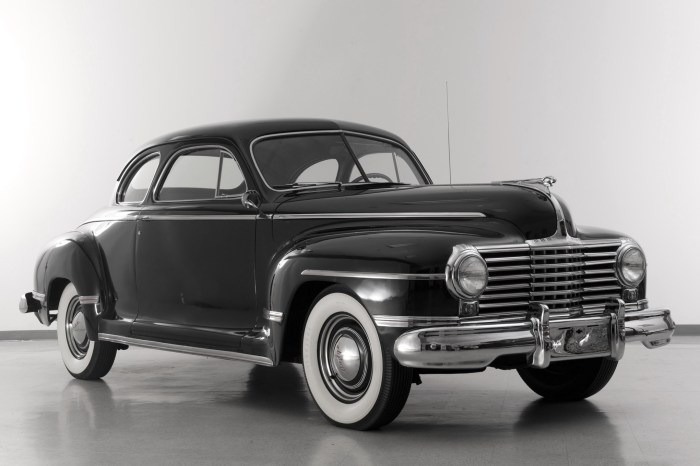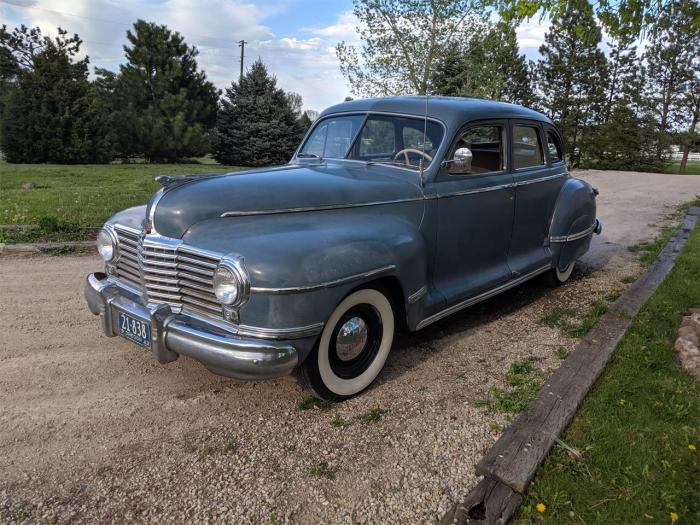The 1942 Dodge Sedan, a symbol of resilience and American ingenuity, arrived on the scene during a time of unprecedented change. The Second World War had cast a long shadow over the nation, impacting every aspect of life, including the automotive industry.
While the war effort demanded resources, Dodge continued to produce vehicles, albeit with a focus on functionality and durability. The 1942 Dodge Sedan, with its streamlined design and robust engine, became a testament to the American spirit, representing a balance between practicality and wartime necessity.
The 1942 Dodge Sedan was a departure from the flamboyant pre-war designs, embodying a simpler aesthetic that prioritized utility. Its exterior featured clean lines and a sturdy, boxy shape, while the interior offered a functional and comfortable space for passengers.
Under the hood, a powerful six-cylinder engine provided reliable performance, capable of handling the demands of both city driving and long journeys. The 1942 Dodge Sedan, though a product of its time, offered a glimpse into the future of American automotive design, showcasing the importance of practicality and durability in a world grappling with uncertainty.
Historical Context

The 1942 Dodge Sedan was a product of a pivotal time in American history, marked by the onset of World War II. The war had a profound impact on the automotive industry, shaping production, design, and the role of car manufacturers like Dodge.
The Impact of World War II on the Automotive Industry
The outbreak of World War II in 1939 dramatically shifted the focus of American industry towards the war effort. The need for military vehicles, aircraft, and munitions led to the conversion of many automotive factories to war production. The government implemented strict rationing of materials, including steel, rubber, and gasoline, limiting the availability of resources for civilian car production.
Dodge’s Role During World War II
Dodge, like other American car manufacturers, played a crucial role in the war effort. The company’s production facilities were repurposed to build military vehicles, including the iconic Dodge WC series trucks, which served as vital transport vehicles for the Allied forces.
Dodge also manufactured engines for aircraft and tanks, contributing significantly to the war effort.
1942 Dodge Sedan Overview

The 1942 Dodge Sedan, a product of the tumultuous wartime era, was a testament to American ingenuity and resilience. This vehicle, built to endure the hardships of wartime, served as both a reliable mode of transportation for civilians and a vital tool for the war effort.
Exterior Design
The 1942 Dodge Sedan sported a classic, boxy design typical of the era. Its exterior featured a long, straight hood, a wide grille with vertical chrome bars, and a simple, functional body. The headlights were positioned on the front fenders, and the taillights were integrated into the rear body panels.
The sedan’s overall design prioritized practicality over flamboyance, reflecting the utilitarian spirit of the time.
Interior Features
Inside, the 1942 Dodge Sedan offered a straightforward and functional interior. The cabin featured a bench seat in the front and a bench seat in the rear, providing seating for up to six passengers. The dashboard was spartan, with a focus on essential gauges and controls.
The interior was typically finished in durable materials like vinyl and cloth, designed to withstand the wear and tear of everyday use.
Engine Options
The 1942 Dodge Sedan was powered by a 230 cubic inch, six-cylinder engine. This engine produced 92 horsepower and was paired with a three-speed manual transmission. The engine provided adequate power for daily driving and could handle light towing duties.
Specifications
- Length:198 inches
- Width:73 inches
- Height:64 inches
- Wheelbase:118 inches
- Curb Weight:3,200 pounds
- Horsepower:92 hp
- Fuel Economy:Approximately 16 mpg
Comparison with Other Vehicles
The 1942 Dodge Sedan competed with other American sedans of the era, such as the Ford Deluxe and the Chevrolet Master. Compared to these rivals, the Dodge offered a more robust and durable build quality. It was known for its reliability and its ability to handle rough roads and harsh conditions.
The 1942 Dodge Sedan, a symbol of wartime resilience, is a prime example of the enduring appeal of classic cars. Its simple lines and robust construction speak to a bygone era, a time when automobiles were built to last.
Even today, the 1942 Dodge Sedan continues to captivate enthusiasts with its timeless design and historical significance.
The Dodge Sedan’s utilitarian design and solid construction made it a popular choice for families and businesses during the war years.
Production and Sales

The 1942 Dodge Sedan, a symbol of resilience and wartime production, was manufactured during a period of immense change and global conflict. The production process reflected the demands of the era, and its sales figures tell a story of adaptation and sacrifice.
The 1942 Dodge Sedan was produced at the Dodge Main plant in Detroit, Michigan, which had been a hub of automotive manufacturing since the early 20th century. The plant’s assembly lines, once humming with the production of civilian vehicles, were now retooled to prioritize the war effort.
The Dodge Sedan, along with other essential vehicles, was built to support the war effort, with materials and resources carefully allocated to ensure the smooth functioning of the American military.
Production Process
The production process of the 1942 Dodge Sedan was heavily influenced by the war effort. To meet the demands of the war, the assembly lines at the Dodge Main plant were streamlined and optimized for efficiency. This meant that many of the usual decorative features and luxury appointments were eliminated to focus on functionality and durability.
The emphasis was on producing a reliable and sturdy vehicle that could withstand the rigors of wartime use.
Sales Figures and Market Share
The 1942 Dodge Sedan was a popular choice for both civilians and the military. However, the war effort significantly impacted the production and distribution of automobiles, including the Dodge Sedan. The demand for automobiles was high, but the government imposed strict restrictions on the production of civilian vehicles.
As a result, sales figures for the 1942 Dodge Sedan were limited compared to pre-war years.
Despite the production constraints, the 1942 Dodge Sedan held a significant market share in the American automobile market. The model’s reliability and durability made it a popular choice for families and businesses that needed a dependable vehicle during the war years.
Moreover, the Dodge Sedan’s popularity was further enhanced by its wartime use, as it was employed by the military for transportation and support roles.
Factors Influencing Popularity
Several factors contributed to the popularity of the 1942 Dodge Sedan, despite the challenging circumstances of the war years. These factors included:
- Reliability and Durability:The Dodge Sedan was known for its robust construction and dependable performance, which were essential qualities during wartime. This reputation for reliability made it a popular choice for families and businesses that needed a vehicle they could trust.
- Military Use:The 1942 Dodge Sedan was widely used by the military for various purposes, including transportation, communication, and support roles. This widespread military use further boosted the model’s popularity and reputation.
- Limited Choices:With the government’s restrictions on civilian vehicle production, the number of available automobiles was significantly reduced. This scarcity made the 1942 Dodge Sedan a more attractive option for consumers, as it was one of the few vehicles readily available.
Technical Features and Innovations

The 1942 Dodge Sedan, produced during the war years, incorporated a number of technical advancements that aimed to improve efficiency, durability, and performance, while also adhering to wartime restrictions on materials and manufacturing processes.
Engine and Transmission
The 1942 Dodge Sedan was equipped with a 230 cubic inch (3.8-liter) straight-six engine, producing 92 horsepower. This engine featured a cast-iron block and head, and utilized a carburetor for fuel delivery. The engine was coupled to a three-speed manual transmission, which was a standard feature in most automobiles at the time.
While not groundbreaking, this powertrain offered reliable performance and fuel efficiency, crucial aspects for a car designed for wartime conditions.
Suspension and Brakes
The 1942 Dodge Sedan employed a robust suspension system, featuring a front independent suspension with coil springs and a rear live axle with semi-elliptic leaf springs. This configuration ensured a comfortable ride and good handling, particularly on rough roads. The braking system consisted of hydraulic drum brakes on all four wheels, providing adequate stopping power for the time.
Body and Interior
The 1942 Dodge Sedan featured a sturdy steel body construction, with a focus on practicality and durability. The interior was designed to be functional, with simple but comfortable seating and minimal embellishments. The car’s interior offered sufficient space for four passengers, with limited trunk space.
Wartime Modifications
Due to wartime restrictions on materials, several modifications were made to the 1942 Dodge Sedan. These included the use of simplified trim and upholstery, and the omission of certain features like chrome plating and decorative elements. Despite these modifications, the car retained its core functionality and durability.
Comparison with Previous and Subsequent Models
Compared to earlier Dodge models, the 1942 Sedan featured a slightly larger engine and a more refined suspension system. The wartime restrictions resulted in a more utilitarian design, with fewer luxury features compared to pre-war models. Following the war, Dodge introduced new models with more powerful engines, automatic transmissions, and advanced suspension systems.
However, the 1942 Sedan remained a reliable and practical vehicle that played a significant role in wartime transportation.
Cultural Significance

The 1942 Dodge Sedan was more than just a car; it was a symbol of resilience and hope during a time of great uncertainty and hardship. The car’s enduring presence in popular culture and its association with historical events continue to resonate with audiences today, showcasing its significant cultural impact.
The 1942 Dodge Sedan as a Symbol of the War Effort
The 1942 Dodge Sedan was produced during World War II, a time when the United States was deeply involved in the global conflict. The car played a vital role in the war effort, serving as a reliable mode of transportation for civilians, military personnel, and essential services.
The car’s rugged design and durability made it ideal for wartime conditions, contributing to the nation’s mobilization and logistics.
Restoration and Preservation

Restoring a 1942 Dodge Sedan is a labor of love that requires dedication, patience, and a deep understanding of the vehicle’s history and mechanics. While the process can be challenging, the reward of owning and driving a piece of automotive history is well worth the effort.
The Process of Restoring a 1942 Dodge Sedan
Restoring a 1942 Dodge Sedan typically involves a comprehensive approach, encompassing various stages:
Disassembly and Assessment
The restoration process begins with a thorough disassembly of the vehicle. This allows for a detailed inspection of each component, identifying areas requiring repair or replacement.
Bodywork
The body of a 1942 Dodge Sedan is often the most challenging aspect of restoration. Rust, dents, and other damage require careful attention and specialized techniques to restore the vehicle’s original shape and integrity.
Paint
Once the bodywork is complete, the vehicle is prepared for painting. This involves sanding, priming, and applying multiple layers of paint to achieve a smooth and durable finish.
Engine and Mechanical Components
The engine and other mechanical components require a complete overhaul. This includes replacing worn parts, rebuilding the engine, and ensuring all systems are functioning correctly.
Interior
The interior of a 1942 Dodge Sedan can be restored to its original glory by reupholstering the seats, replacing the carpets, and restoring the dashboard and other interior components.
Challenges of Restoring a 1942 Dodge Sedan
Restoring a 1942 Dodge Sedan presents several challenges:
Availability of Parts
Finding original or reproduction parts for a 1942 Dodge Sedan can be difficult. Many parts are no longer in production, requiring resourceful sourcing from specialized suppliers or salvage yards.
Expertise
Restoring a 1942 Dodge Sedan requires specialized expertise in various areas, including bodywork, paint, engine rebuilding, and interior restoration.
Time and Cost
Restoring a 1942 Dodge Sedan is a time-consuming and expensive process. It can take months or even years to complete, depending on the extent of the restoration.
The Value of Preserving Vintage Vehicles
Preserving vintage vehicles like the 1942 Dodge Sedan is essential for several reasons:
Historical Significance
Vintage vehicles represent a tangible link to the past, providing insights into automotive design, technology, and social history.
Cultural Heritage
Vintage vehicles are often associated with specific eras and cultural movements, preserving a sense of nostalgia and cultural identity.
Mechanical Innovation
Vintage vehicles showcase the ingenuity and craftsmanship of earlier generations, highlighting the evolution of automotive technology.
Resources for Restoring or Collecting 1942 Dodge Sedans
Several resources can assist individuals interested in restoring or collecting 1942 Dodge Sedans:
Clubs and Organizations
Dodge car clubs and organizations provide a platform for enthusiasts to connect, share knowledge, and access resources.
Online Forums and Communities
Online forums and communities dedicated to vintage vehicles offer a wealth of information, advice, and support for restoration projects.
Specialized Suppliers
Specialized suppliers offer parts, tools, and services specifically designed for vintage vehicles.
Auction Houses and Dealerships
Auction houses and dealerships specializing in classic cars can provide opportunities to purchase and sell 1942 Dodge Sedans.
Conclusive Thoughts

The 1942 Dodge Sedan stands as a poignant reminder of a pivotal moment in American history. It represents a time of sacrifice, innovation, and unwavering determination. This vehicle, a product of wartime ingenuity, embodied the spirit of resilience and practicality that defined the era.
The 1942 Dodge Sedan, though a mere automobile, became a symbol of the American spirit, a testament to the ability to adapt and persevere in the face of adversity. It serves as a reminder of the enduring legacy of American automotive excellence and the profound impact of historical events on the design and production of vehicles.